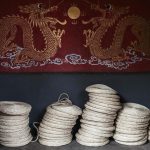Hey there! Ever wonder what fabrics the Indus Valley Civilization used? Well, they were all about cotton! It was a staple fabric for them, and they used it to make a variety of clothing and textiles.
But that's not all – they also made use of wool, linen, silk, and even hemp for different purposes.
So, if you're interested in mastering the knowledge of ancient textile production, you're in for a fascinating journey through the fabrics of the Indus Valley Civilization.
Let's dive in and explore the rich tapestry of materials and techniques that were an integral part of their vibrant culture.
Key Takeaways
- Cotton was a staple fabric used for clothing, household items, and trade, showcasing the advanced nature of the Indus Valley civilization.
- Wool was versatile and suitable for various textile production techniques, providing warmth and insulation, and highlighting the advanced skills of the civilization in working with wool.
- Linen was lightweight, comfortable in the hot and humid climate, and held cultural and economic significance in trade and craftsmanship.
- Silk added luxury and elegance to clothing, symbolizing wealth and status, and reflecting the cultural refinement and sophisticated tastes of the Indus Valley people.
Cotton: A Staple Fabric of the Indus Valley
Cotton was a staple fabric of the Indus Valley civilization, used for a wide range of purposes including clothing, household items, and trade. The Indus Valley people were pioneers in cotton cultivation, mastering the art of growing and processing this versatile material. Their expertise in cotton cultivation allowed them to produce an abundance of cotton, which fueled a thriving textile trade within and beyond their civilization. The ancient craftsmanship of the Indus Valley is evident in the intricately woven cotton garments discovered at archaeological sites. These artifacts showcase the skill and artistry of the civilization's weavers, who created finely crafted clothing using techniques that are still admired today.
The Indus Valley's use of cotton extended beyond clothing; they utilized this fabric for household items such as ropes, fishing nets, and even as a form of currency for trade. The widespread use of cotton in various aspects of daily life highlights its significance in the Indus Valley civilization. This early mastery of cotton cultivation and the utilization of cotton in textile trade and clothing demonstrate the advanced nature of this ancient civilization.
Wool and Its Significance in Textile Production
When considering the fabrics utilized by the Indus Valley civilization, wool played a significant role in textile production. The significance of wool in this ancient civilization lies in its versatility and suitability for various textile production techniques. Wool was a crucial resource for the Indus Valley people, providing them with the means to create a wide array of textiles to meet their various needs.
The significance of wool in textile production can't be overstated. Its natural insulating properties made it an ideal choice for creating warm clothing, especially in the colder regions where the civilization thrived. Additionally, wool was also used to produce durable and long-lasting textiles, such as blankets, rugs, and other household items. The ability of wool to be spun into different yarn weights allowed the Indus Valley people to create textiles of varying thickness and strength, catering to different purposes.
In the context of textile production techniques, wool was commonly spun into yarn using drop spindles or simple looms, showcasing the advanced skills and knowledge of the Indus Valley civilization in working with this material. The utilization of wool in textile production was a testament to the resourcefulness and ingenuity of the ancient Indus Valley people.
Linen: The Lightweight Fabric of Choice
You might be surprised to learn that linen was a widely used lightweight fabric in the textile production of the Indus Valley civilization. The Indus Valley people were skilled in linen production, and this fabric was a popular choice due to its breathability and versatility. Here are a few interesting facts about linen and its significance in the ancient civilization:
- Linen Production: The production of linen involved a meticulous process of cultivating flax plants, extracting fibers, and weaving them into fine linen textiles. The Indus Valley civilization was known for its expertise in this intricate craft.
- Lightweight Textiles: Linen was favored for its lightweight nature, making it ideal for the hot and humid climate of the region. The fabric offered comfort and coolness, which were essential in the ancient times.
- Versatile Use: Linen was used for various purposes, including clothing, household textiles, and even as a form of currency. Its versatility and durability made it a valuable asset in the Indus Valley society.
- Cultural Significance: Linen held cultural and economic significance, playing a vital role in trade and craftsmanship within the civilization.
The widespread use of linen underscores its importance in the textile industry of the ancient Indus Valley civilization.
Silk and Its Luxurious Role in Indus Valley Clothing
When it comes to luxury and sophistication in clothing, silk has always been a top contender.
In the context of the Indus Valley Civilization, silk played a crucial role in the creation of luxurious fabrics and garments. The use of silk in Indus Valley clothing added a touch of opulence and elegance to the attire of the ancient civilization.
Indus Valley Silk
Silk frequently adorned the clothing of the Indus Valley people, adding a touch of luxury and elegance to their attire. The Indus Valley civilization was known for its participation in the silk trade, acquiring this luxurious fabric through trade routes. Ancient weaving techniques were used to create exquisite silk garments, showcasing the craftsmanship and artistry of the civilization.
Here are four fascinating aspects of Indus Valley silk:
- Symbolism: Silk held symbolic significance and was often associated with wealth and status, highlighting its esteemed role in the society.
- Dyeing Techniques: Indus Valley artisans mastered the art of dyeing silk with vibrant colors, creating visually stunning and intricate patterns.
- International Trade: The Indus Valley civilization engaged in extensive trade, exporting their fine silk fabrics to distant lands, showcasing their advanced commercial networks.
- Cultural Significance: The use of silk in clothing reflected the sophisticated tastes and cultural refinement of the Indus Valley people.
Luxurious Clothing Material
Indulge in the luxurious allure of silk as a coveted clothing material in the Indus Valley civilization. Silk production in the ancient Indus Valley civilization was a testament to their advanced craftsmanship. The luxurious garments made from silk were highly sought after and symbolized wealth and status. The exquisite fabric was favored for its lustrous sheen, soft texture, and lightweight feel, making it ideal for creating opulent attire. The Indus Valley people were skilled in the art of silk production, utilizing advanced techniques to cultivate and weave this precious material. Silk garments adorned with intricate designs and vibrant colors were a hallmark of the elite, reflecting the sophistication and refinement of the ancient civilization.
| Advantages of Silk in Indus Valley Clothing | |
|---|---|
| Lustrous Sheen | Lightweight Feel |
| Soft Texture | Symbol of Wealth and Status |
Hemp: A Versatile Material for Everyday Use
Hemp has been used for centuries due to its durability and comfort, making it an ideal material for everyday use.
You'll learn about the ancient cultivation of hemp and how it played a significant role in the fabric choices of the Indus Valley Civilization.
Additionally, we'll explore the modern applications of hemp, showcasing its continued relevance in today's world.
Hemp's Durability and Comfort
You can find a variety of durable and comfortable fabrics for everyday use, and one such material is hemp. Here are four reasons why hemp is a versatile and practical choice:
- Durability: Hemp fabric is known for its exceptional strength, making it long-lasting and resistant to wear and tear.
- Sustainability: Hemp is a highly sustainable material, as it requires minimal water, pesticides, and herbicides to grow, making it an eco-friendly option.
- Comfort: Despite its durability, hemp fabric is also remarkably comfortable, with a soft texture that becomes even more pleasant with each wear and wash.
- Versatility: Hemp can be used to create a wide range of products, from clothing and accessories to home textiles, showcasing its adaptability for various everyday uses.
Hemp truly stands out as a reliable and comfortable fabric that caters to both practicality and comfort.
Ancient Hemp Cultivation
When considering the fabrics utilized by the Indus Valley Civilization, it's worth noting the historical significance of ancient hemp cultivation as a versatile material for everyday use.
Ancient hemp cultivation played a crucial role in sustainable fabric production, providing the Indus Valley Civilization with durable hemp textiles. This cultivation not only satisfied their clothing needs but also had a positive environmental impact.
Hemp is known for its resilience and adaptability, making it an ideal choice for various everyday uses. The ancient cultivation of hemp demonstrates the civilization's forward-thinking approach to fabric production, prioritizing sustainability and durability.
Hemp's Modern Applications
Indus Valley Civilization utilized hemp for a variety of modern applications, making it an incredibly versatile material for everyday use. Today, the use of hemp extends beyond traditional textiles to a wide range of products.
Here are a few ways hemp is being used in modern applications:
- Hemp Clothing: Hemp fibers are being used to create durable and stylish clothing options, offering a sustainable alternative to conventional textiles.
- Sustainable Textiles: Hemp is being used to produce a variety of sustainable textiles, including bed linens, towels, and upholstery fabrics, contributing to eco-friendly living.
- Building Materials: Hemp is being incorporated into construction materials such as hempcrete, providing a sustainable and energy-efficient alternative for building homes and structures.
- Biodegradable Plastics: Hemp-based plastics are being developed as a renewable and biodegradable alternative to traditional plastics, reducing environmental impact.
Dyeing Techniques and Colorful Textile Traditions
Dyeing techniques and colorful textile traditions were integral to the fabric production of the Indus Valley Civilization, showcasing the mastery of ancient artisans in creating vibrant and enduring hues. Tie-dye techniques, a method where sections of fabric are bound or twisted to create patterns, were widely used. The artisans of the civilization were adept at employing natural dyeing methods, utilizing locally available resources to produce a stunning array of colors. Madder roots were used to create red and pink hues, while indigo plants yielded rich blues. Additionally, turmeric was employed to achieve bright yellow tones, and various other plants and minerals were harnessed to expand the palette.
The Indus Valley Civilization's dyeing expertise was unparalleled for its time, and their colorful textile traditions continue to inspire artisans and designers today. The ability to effectively utilize natural dyes and employ intricate tie-dye techniques underscored the sophistication of their textile industry. The enduring beauty of their dyed fabrics serves as a testament to the creativity and skill of the ancient artisans, leaving a rich legacy that continues to captivate modern audiences.
Weaving and Embroidery: Artistic Expressions in Fabric
Utilizing the skills and expertise previously highlighted in dyeing techniques, artisans of the Indus Valley Civilization demonstrated remarkable proficiency in weaving and embroidery, creating intricate and expressive fabric artistry.
- Weaving Techniques: The Indus Valley Civilization mastered various weaving techniques, including plain weave, twill weave, and satin weave, to produce a wide array of fabrics with different textures and patterns.
- Embroidery Styles: Artisans adorned fabrics with exquisite embroidery, using techniques such as chain stitch, running stitch, and satin stitch to create elaborate designs that showcased the civilization's artistic finesse.
- Cultural Symbolism: The weaving and embroidery of the time weren't merely decorative; they held deep cultural and symbolic significance. Patterns and motifs often conveyed important cultural narratives, religious beliefs, and societal values, offering a glimpse into the civilization's rich heritage.
- Artistic Expressions: Weaving and embroidery weren't just crafts but forms of artistic expression. The intricate details and precision in fabric artistry reflected the Indus Valley Civilization's dedication to creating beauty and meaning through textiles, leaving a lasting legacy in the history of fabric arts.
Frequently Asked Questions
How Did the Indus Valley Civilization Dye Their Fabrics?
To dye fabrics, the ancient Indus Valley civilization used natural dyes and employed various techniques such as tie-dye and resist dyeing. They extracted colors from plants and minerals, creating vibrant hues that adorned their textiles.
What Type of Tools Did They Use for Weaving and Embroidery?
To create beautiful textiles, the Indus Valley Civilization used weaving tools like looms and spindles. They also employed sophisticated embroidery techniques, using needles and various stitches to embellish their fabrics with intricate designs and patterns.
Did the Indus Valley Civilization Trade Their Fabrics With Other Civilizations?
Yes, the Indus Valley Civilization extensively traded their fabrics with other civilizations. Their sophisticated trade networks facilitated cultural exchange, allowing them to export their textiles and import materials that enriched their own textile production.
What Were the Social and Cultural Significance of Different Fabrics in the Indus Valley Civilization?
In the Indus Valley Civilization, fabrics held great social customs and cultural traditions. Different textiles were woven and dyed for specific rituals and ceremonies, reflecting the diverse and intricate societal roles and beliefs of that time.
Were There Any Specific Rituals or Traditions Related to Fabric Production and Usage in the Indus Valley Civilization?
When it comes to fabric production rituals in the Indus Valley Civilization, specific techniques and traditions were observed. Traditional fabric usage was deeply intertwined with cultural and religious practices, reflecting the significance of textiles in their society.







